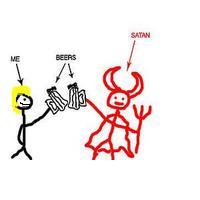The subject today is the town of Gyruum, now called Jarrow on the northeast coast of Britain. The first monastery was founded there in 674, per the Cornwell reader blog. The Venerable Bede wrote his history of the English Church there, finishing around 731.
The blog mentions the monastery was destroyed by the Vikings around 860 which doesn't totally jive with the books dates (It's off by around 8 or 10 years?) But why quibble? It would take some doing to dig into the minutiae of this event and Cornwell clearly has done a lot of research. At any rate, Ragnar and company return from conquering East Anglia (leaving Alfred's Wessex the only sovereign English kingdom left) to quell some civil unrest in York, their home turf. Take it away, Bernard:
It seemed six Danes, all of them masterless men, had gone to Gyruum and demanded to see the monastery's treasury and, when the monks claimed to be penniless, the six had started killing, but the monks and fought back and, as there were over a score of monks, and as they were helped by some men from the town, they succeeded in killing the six Danes who had been spitted on posts and left to rot on the foreshore. Thus far, as Ragnar admitted, the fault lay with the Danes, but the monks, encouraged by this slaughter, had marched west up the river Tine, and attacked a Danish settlement...
And there, people were tortured and killed in what the monks had decided was now a holy war. Women were raped by monks while nuns cheered them on. Ok, the Danes are doing the same shit themselves but I love this cheeky history for pointing out the Church proper was often (or never) any better than their opponents. As retribution, Ragnar finds out where the biggest monasteries and convents in the area are and his men burn them to the ground and rape and pillage, etc. Which all leads to this funny coda from Uhtred:
The tale is still told as evidence of Danish ferocity and untrustworthiness, indeed every English child is told the story of the nuns who cut their faces to the bone so that they would be too ugly to rape...I remember one Easter listening to a sermon about the nuns, and it was all I could do not to interrupt and say that it had not happened as the priest described. The priest claimed that the Danes had promised no monk or nun would ever be hurt in Northumbria, and that was not true, and he claimed that where was no cause for the massacres, which was equally false, and then he told a marvelous tale how the nuns had prayed and God had placed an invisible curtain at the nunnery gate, and the Danes had pushed against the curtain and could not pierce it, and I was wondering why, if the nuns had this invisible shield, they had bothered to scar themselves, but they must have known how the story would end, because the Danes were supposed to have fetched a score of small children from the nearby village and threatened to cut their throats unless the curtain was lifted, which it was.
(disclaimer: Needless to say, I do not endorse rape, murder and pillaging in general and certainly not against monks and nuns.)
One of the recurring themes in the book is the Danes' befuddlement at Christianity. There is another great scene where Edmund of East Anglia surrenders to the Danes but demands they be baptized and become Christian as a condition of his surrender which the translator conflated with "washing" which confused the Danish side. Ivar finally understands with Uhtred's help and having asked earlier about a picture of the martyrdom of Saint Sebastian says he will agree to become Christian if Edmund, too, can live after being pierced by arrows. Ivar isn't even being cruel here, he genuinely wants to know. And it's logical, really. If the English god can protect you from arrows, it's worth switching sides or adding him to your pantheon at least. Edmund, the poor schmuck, agrees when he realizes he's talked himself into a corner and Ivar and his men shoot him with arrows. The results were predictable. As to the fate of the real Edmund, it's not clear. Also predictable, he's considered a martyr too.
It's a famous subject in Renaissance art, the Sebastian story. Like many a tale of Catholic miracles, it's rather anti-climactic since he after the arrows didn't work, the Romans allegedly clubbed him to death.
Here is Sebastian, in happier times:
As always, the loincloth is holding on just enough to spare us pubes.


No comments:
Post a Comment